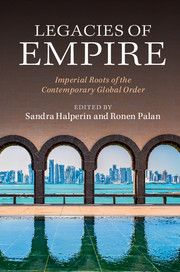Book contents
- Frontmatter
- Contents
- List of figures
- List of tables
- List of contributors
- Acknowledgments
- 1 Introduction: legacies of empire
- Part I Incomplete transitions from empires to nation states
- 2 Political military legacies of empire in world politics
- 3 The second British Empire and the re-emergence of global finance
- 4 Imperial city states, national states and post-national spatialities
- Part II Legacies of non-European empires in today's world
- Part III The future legacies of the American Empire
- Index
- References
3 - The second British Empire and the re-emergence of global finance
from Part I - Incomplete transitions from empires to nation states
Published online by Cambridge University Press: 05 August 2015
- Frontmatter
- Contents
- List of figures
- List of tables
- List of contributors
- Acknowledgments
- 1 Introduction: legacies of empire
- Part I Incomplete transitions from empires to nation states
- 2 Political military legacies of empire in world politics
- 3 The second British Empire and the re-emergence of global finance
- 4 Imperial city states, national states and post-national spatialities
- Part II Legacies of non-European empires in today's world
- Part III The future legacies of the American Empire
- Index
- References
Summary
The British Empire was a remarkable empire for many good reasons. First, it belonged to that very rare club of empires, which included as far as I can tell only two (the Spanish ‘empire’) over which the sun never set. Indeed, at its peak, the British Empire was the largest formal empire the world had ever known. True to size, the British Empire extended its power and influence in the nineteenth century over a very large tract of lands mostly in Latin and Central America which was formally sovereign but colloquially known as the ‘informal empire’. Second, considering its size and wealth, the rapid and generally speaking orderly collapse of the British Empire after World War II was even more remarkable. By the 1980s, the largest empire the world has ever seen shrank down to contain just remnants and debris, including the United Kingdom, three adjacent Crown territories – Jersey, Guernsey and the Isle of Man – and fifteen dependent territories – since 2002 called ‘overseas territories’ – which include some small Caribbean islands, the Falkland Islands and Gibraltar. Collectively these overseas territories encompass a population of approximately 260,000 people and a land area of 1.7 million square kilometres, the vast majority of which constitutes the British Antarctic Territory.
A third remarkable fact about the British Empire is that while it disappeared completely from most contemporary maps of the world, it remains very much alive in one crucial map: the map of contemporary international finance.
- Type
- Chapter
- Information
- Legacies of EmpireImperial Roots of the Contemporary Global Order, pp. 46 - 68Publisher: Cambridge University PressPrint publication year: 2015
References
- 8
- Cited by



